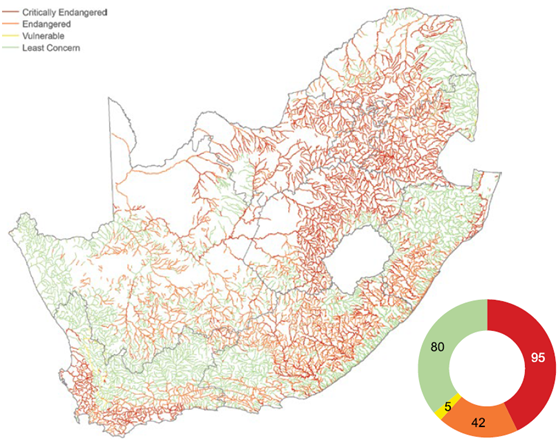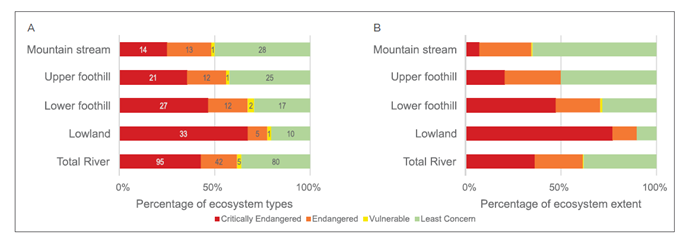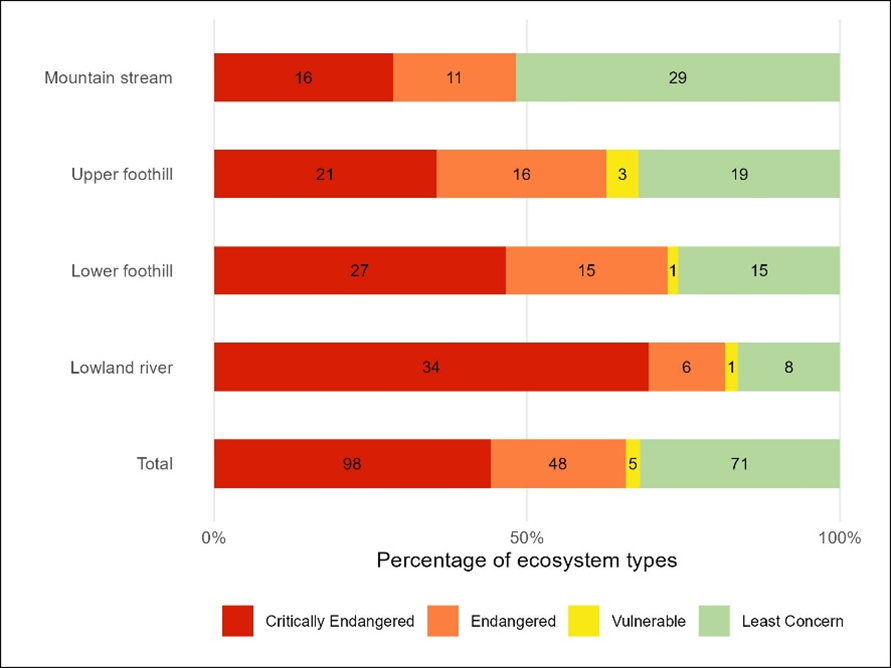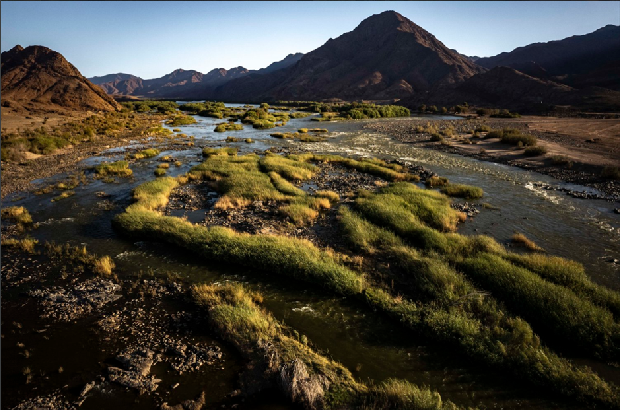Summary
Rivers are the second most threatened ecosystem in South Africa, with over 60% of river types assessed as Threatened. This places the vital services they provide and the incredible biodiversity they support at great risk.
of 222 river ecosystem types
Threatened
of 222 river ecosystem types
Least Concern
Of South Africa’s 222 river ecosystem types, 43% are Critically Endangered, 19% are Endangered, 2% are Vulnerable, and 36% are of Least Concern. Ecosystem threat status varies across geomorphological zones with 67% of lowland river types being Critically Endangered compared to only 25% of mountain stream types.

Figure 1. Ecosystem threat status for river ecosystem types. The inset doughnut shows the number of ecosystem types per threat category.


Figure 2. River ecosystem threat status within each geomorphological zone (i.e. slope category). (a) The percentage of ecosystem types per threat category (labelled with actual value) with the total for all rivers at the bottom (n = 222); (b) the percentage of river length (km) within each threat category with the total length for all rivers (length = 147 180 km) at the bottom – providing an indication of the relative extent of each category. [a lot of tables, think about how to present them]
Insert tables, graphs and figures.
Some text with a footnote1.

Methods
The Red List of Ecosystems (known as Ecosystem Threat Status in South Africa) assesses the risk of collapse of each ecosystem type based on a range of criteria on extent condition and pressures faced by each ecosystem type. For consistency with past NBAs this assessment follows the methods developed by [Nel et al., 2007](DOI: 10.1111/j.1472-4642.2006.00308.x) and modified by van Deventer et al., 2019. Each of the 222 river ecosystems types were assigned to one of the four risk categories: Critically Endangered, Endangered, Vulnerable and Least Concern.
The analysis approach of van Deventer et al., 2019 uses the proportion of each ecosystem type that is in a good to fair condition (PES class A B and C) and a set of thresholds. If less than 20% of a type (measured by length of river segment) is in a A or B condition then the type is categorised as Critically Endangered; if between 20-35% of the type is in A or B condition then the type is categorised as Endangered; if less than 60% of the type is in A or or C condition then the type is categorised as Vulnerable; if none of these thresholds are crossed then the type is Least Concern. This method aligns with the South African Framework for Threatened ecosystems but not the IUCN RLE 1.1. Processes to transition to the IUCN framework are underway - but in the interest of comparing past results, the 2011 methods have been implemented.
Technical documentation
Code repository: github.com/SANBI-NBA/templates
Data repository: OPUS, Figshare, KNB or BGIS - link to the specific page within these websites containing your data.
Technical report: Add link to technical report in PDF format
Other publications
Jordaan, M.S., et al. 2020. Protected areas and endemic freshwater fishes of the Cape Fold Ecoregion: missing the boat for fish conservation? Frontiers in Environmental Science 8:502042. doi: 10.3389/fenvs.2020.502042
References
Notes
Insert a basic footnote by using the Visual editor’s Insert > Footnote. Type the footnote text into the box provided. Quarto will automatically number your references and footnotes in the order that they are inserted in the text.↩︎